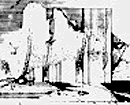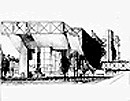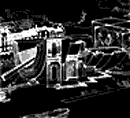Paris 1972 - 76
by
VITTORIO MAZZUCCONI
| BACK | HOMEPAGE | ARCHITECTURE | PAINTING | PHILOSOPHY | FOUNDATION |
| B.1.3.2 |
| LUTETIA Paris 1972 - 76 by VITTORIO MAZZUCCONI |
Introduction (2/2) |
Introduction |
Vittorio Mazzucconi worked in Paris for fifteen years and spent a part of his youth in this city, which opened for him many ideas, horizons and expressive possibilities. His debut was the building at Avenue Matignon 22, in which the theme of inserting modern architecture into a historical context is turned around: the memory of history is instead inserted into the contemporary experience. The façade expresses the centrality, the heart, that the Projects for Milan had pointed towards as the ultimate end. Mazzucconi arrived at an understanding of the nucleus in one place - Milan, Città dei Navigli - and this acheivement made him aware of the presence of a nucleus in any other place: this is how the nucleus of Paris emerged, its very heart, through this terrific façade. The apocalyptic perspective of the book of Milan becomes in this building and in many other projects for Paris an announcement of destruction, and also of a new harmony and civilization. |
 |
In addition to the Avenue Matignon, façade, many of Mazzucconi’s projects exemplify this creative tension; among the first was the proposal for Les Halles, which includes a great Ark. The idea was born in a profound synthesis with the archetype, a symbol of Paris, which shares with the vessel a rapport with the river, an idea revisited many years later in the Tete-Défense project. |
 |
The Aix-Etoile project for a small satellite city near Paris expresses the theme of foundation; as if a small city in the suburbs could, under a spell, recall the sacred birth of a real city, like in ancient Rome. Paris itself had been a Roman city. Under the name Lutetia, the birth of the ancient city is revived in a mysterious way. |
 |
Other Arks figure in projects such as St-Germain-en-Laye,Cultural Center, the Opera-Bastille, and Villette in a continuous, creative flow. |
 |
One Ark was realized in the Massiccio Centrale, in the magical landscape
of Lioran.
In this site a touristic village borders a small, alluvial meadow crowned
by a crater; at the other end appears the silhouette of the Ark
of Snow which advances like a great ship. |
 |
The Citadelle,
to a typical borough of Paris, l’Avenue d’Italie, the spirit
of a fortified complex. The structure seems to resist the encroaching agression
of 1950’s high rise architecture, while emphasizing the softness and
privacy of an "internal architecture", protected by fortification
on the street. |
 |
Vittorio Mazzucconi designed projects for other French cities as well. One of these projects was for Nancy, a city with a splendid 18th-century center bordering the zone du Canal, an abandoned and declining area. Mazzucconi’s project sought to revitalize this zone, through new settings, paths and monuments, all surrounding a basin in which they were mirrored. |
| Again in this project we witness a fusion of history, topography, beauty
and even degradation, realistic and poetic motives, symbols associated with
the archetype of a city ... all in harmony, suffused with a numinous pathos
to which Mazzucconi holds the secret key. |
|